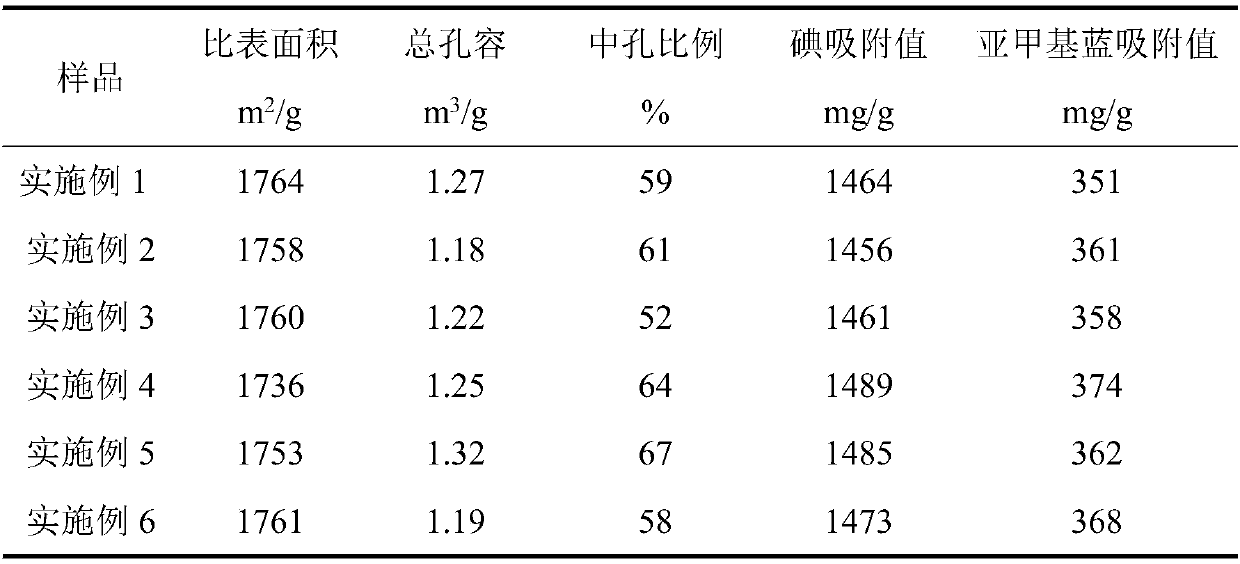Method for preparing activated carbon by taking coconut shells as raw materials
A technology for preparing activated carbon and coconut shells, applied in chemical instruments and methods, inorganic chemistry, non-metallic elements, etc., can solve problems such as insufficient activated carbon performance, and achieve the effect of good adsorption performance and high specific surface area
- Summary
- Abstract
- Description
- Claims
- Application Information
AI Technical Summary
Problems solved by technology
Method used
Image
Examples
Embodiment 1
[0039] In the present embodiment, the method for preparing gac from coconut shell comprises the steps:
[0040] S1, the mixing of raw materials: choose coconut shell, pulverize, obtain coconut shell powder; Dry described coconut shell powder to water content rate 18%; Select concentration to be the thermal food grade phosphoric acid of 64%-, according to coconut shell powder: Thermal food-grade phosphoric acid = 1:1.5 for mixing, kneading and stirring evenly, and static soaking for 40 minutes to obtain a mixed material;
[0041] S2. High-temperature carbonization: take the mixed material obtained in step S1 and place it in a muffle furnace for carbonization treatment to obtain a carbonized material; wherein, the carbonization temperature is 270° C., and the carbonization time is 40 minutes;
[0042] S3. Activation: take the carbonized material obtained in step S2, and activate it to obtain the activated material; wherein, the activation temperature is 510° C., and the activati...
Embodiment 2
[0050] In the present embodiment, the method for preparing gac from coconut shell comprises the steps:
[0051]S1, the mixing of raw materials: select coconut shell, pulverize, obtain coconut shell powder; Dry described coconut shell powder to moisture content 24%; Select the thermal method food-grade phosphoric acid that concentration is 78% for use, according to coconut shell powder: heat French food-grade phosphoric acid = 1:1.9 ratio for mixing, kneading and stirring evenly and static soaking for 55min to obtain the mixed material;
[0052] S2. High-temperature carbonization: take the mixed material obtained in step S1 and place it in a muffle furnace for carbonization treatment to obtain a carbonized material; wherein, the carbonization temperature is 335° C., and the carbonization time is 55 minutes;
[0053] S3. Activation: take the carbonized material obtained in step S2, and activate it to obtain the activated material; wherein, the activation temperature is 560° C., ...
Embodiment 3
[0061] In the present embodiment, the method for preparing gac from coconut shell comprises the steps:
[0062] S1, the mixing of raw materials: select coconut shell, pulverize, obtain coconut shell powder; Dry described coconut shell powder to water content rate 21%; Select the thermal method food grade phosphoric acid that concentration is 70% for use, according to coconut shell powder: heat French food-grade phosphoric acid = 1:1.7 ratio for mixing, kneading and stirring evenly and static soaking for 48min to obtain the mixed material;
[0063] S2. High-temperature carbonization: the mixed material obtained in step S1 is placed in a muffle furnace for carbonization treatment to obtain a carbonized material; wherein, the carbonization temperature is 300° C., and the carbonization time is 50 minutes;
[0064] S3. Activation: take the carbonized material obtained in step S2, and activate it to obtain the activated material; wherein, the activation temperature is 530° C., and t...
PUM
 Login to View More
Login to View More Abstract
Description
Claims
Application Information
 Login to View More
Login to View More - R&D
- Intellectual Property
- Life Sciences
- Materials
- Tech Scout
- Unparalleled Data Quality
- Higher Quality Content
- 60% Fewer Hallucinations
Browse by: Latest US Patents, China's latest patents, Technical Efficacy Thesaurus, Application Domain, Technology Topic, Popular Technical Reports.
© 2025 PatSnap. All rights reserved.Legal|Privacy policy|Modern Slavery Act Transparency Statement|Sitemap|About US| Contact US: help@patsnap.com

